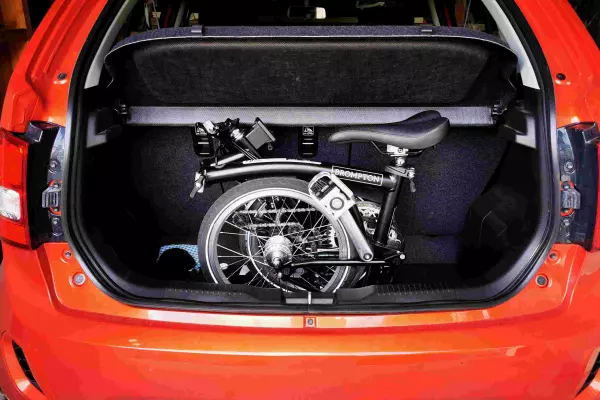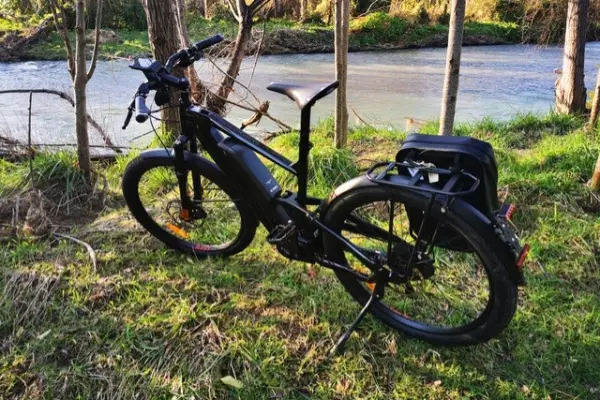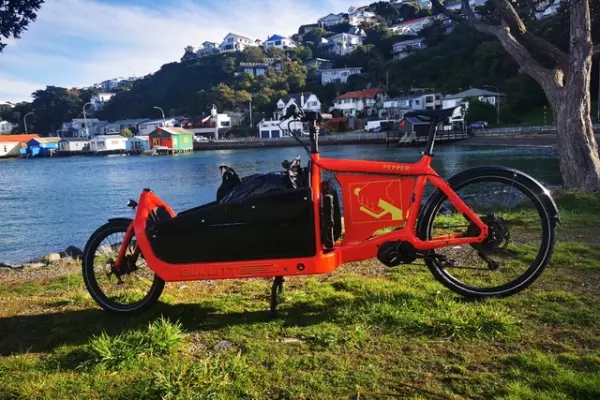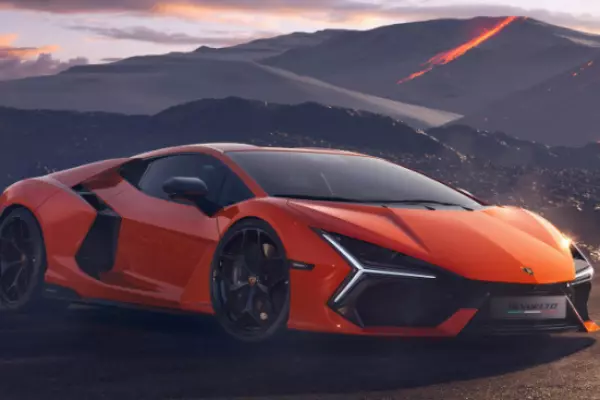The Riese & Müller Homage is an impressive vehicle with an equally impressive price tag which starts from $10,989.
It says something about the ubiquity of motor cars that Dan Mikkelsen – owner and founder of Wellington’s Bicycle Junction – describes the German brand as the Mercedes-Benz of e-bikes.
There’s arguably no one in the capital who has done more to promote so-called utility cycling – cycling for commuting rather than simply leisure or sport – than Mikkelsen, so his choice of a car metaphor is as telling as it is ironic.
But as I sped down the Ngauranga Gorge the metaphor made sense. The Homage is as stable as a motorbike and the ride as smooth as any high-end car.
Calling the striking-looking machine an e-bike doesn’t really do it justice. The full-suspension Homage, weighing in at a hefty 35kg, is a far cry from the first generation of e-bikes that were, as often as not, standard-issue bicycles with an electric hub-motor on either the front or back wheel.
The Homage is powered by a centrally mounted, top-of-the-line Bosch motor, which assists the rider to reach up to 45km/h.
The distinctively angled step-through frame makes for easy mounting. The rider has four levels of assist to choose from: eco, tour, sport and turbo.
The Homage is what’s known as a pedelec – an e-bike that requires the rider to pedal for it to move; there’s no throttle for quick getaways. But in either the sport or turbo mode little effort is needed to keep up with the cars on city streets.
On Oriental Parade I found myself having to consciously slow down to remain within the 40km/h limit. (Anyone choosing to ride on the shared pathway would be well advised to switch the setting down to eco and slow down to a more pedestrian-friendly speed.)
E-bikes, it’s often said, flatten hills and eliminate headwinds. The Homage adds a permanent tailwind and Lance Armstrong’s legs to the mix.
In sport mode I rode up Brooklyn Hill at 20km/h fairly effortlessly, and then as I headed down through Happy Valley to Ōwhiro Bay, a combination of gravity and fairly leisurely pedalling saw me travelling at around 50km/h most of the way.
Drop it like it's hot
One nifty feature is the dropper seat post. I was sceptical of its value at first, associating such a feature – which, as its name suggests, lets the rider adjust the seat height with the push of button – with mountain biking and steep and technically challenging slopes where lowering your seat is a must.
But as it turns out, dropper posts really come into their own at traffic lights. There’s no need to hop off the seat: a push of the button and the post drops down as you come to a stop, letting your feet easily reach the ground. And then as you take off – leaving all but boy racers in your dust – another push of the button gently raises the seat to your pre-set preferred height.
The Homage comes with not one but two batteries. A round trip from my home in the central city out to Mākara and back through Johnsonville in a mixture of sport and turbo modes – a ride of about 60km – used up less than half the battery capacity.
The test bike was fitted with a 14-speed, internal Rohloff hub. This optional extra is an engineering wonder, with a massive 526% range between the top and bottom gears.
But is such a big range of gears really necessary when you have a grunty electric motor to assist you? I wasn’t convinced until I rode up Wellington’s steepest road, Winchester St in Kaiwharawhara. In first gear, I found the hill definitely doable, but it required a bit of leg power; with a full load of shopping, it might have been a challenge keeping the front wheel on the ground. And the top gear is nice to have on flat roads with a tailwind or if you want to see just how fast you can go down a steep hill. The answer? Very fast.
Changing gears
The Homage’s internal hub allows Riese & Müller to dispense with the chain for a belt-drive. There’s no need for any oil, and the belts far outlast the chains. (I’ve done more than 11,000km on a belt-drive bike and it’s still going strong. A chain and cassette would typically need replacing three or four times over that sort of mileage.)
The hub is matched with an electric shifter, meaning there’s no need to stop pedalling to change gears as there is on Rohloff-equipped bikes with manual shifters.
Those opting for a more traditional drive-chain can shave nearly $3000 off the price of the Homage.
Other reviewers have suggested larger brake rotors would improve the braking, but I can’t say this occurred to me. Slowing from 80km/h to around 30km/h as I exited the Ngauranga Gorge was smooth and effortless.
The bike’s onboard computer – mounted on the handlebars – is as comprehensive and at times baffling as that of any modern car. It connects to your cellphone, has a GPS with a mapping service, and provides an abundance of fitness-related statistics.
If the Homage is the Mercedes-Benz of bicycles, it’s definitely an SUV rather than a low-slung saloon. It’s as at home on gentle off-road trails and metal roads as it is on city streets.
But, like the SUVs that clog up our supermarket carparks, it isn’t designed for serious off-road travel; it’s perfect for forest trails but not hardcore mountain biking.
What’s not to like? Other than the price, very little. If you’re after comfort, great range, and a bike that’s stylish, practical and fun to ride, the Riese & Müller Homage ticks all the boxes.
But for most people, that price will be a sticking point. It’s worth noting that someone buying a new Tesla is at present entitled to a care-for-the-environment rebate of more than $8600 and saves around $700 a year in road-user charges. In contrast, someone caring for the environment by buying an e-bike – or an ordinary bike, for that matter – gets nothing.













